Spatiotemporal Distribution and the Driving Force of the Food-Energy-Water Nexus Index in Zhangye, Northwest China
Abstract
1. Introduction
2. Materials and Methods
2.1. Study Area
2.2. Data Processing
2.3. Methods
2.3.1. FEW Index
- (1)
- Food Subindex
- ①
- Food Availability
- ②
- Food Accessibility
- a.
- Food Accessibility
- b.
- Diversity
- (2)
- Energy Subindex
- ①
- Energy Availability
- ②
- Energy Accessibility
- (3)
- Water Subindex
- ①
- Water Availability
- ②
- Water Accessibility
- ③
- Water Adaptive Capacity
2.3.2. Multiple Stepwise Linear Regression Model
3. Results and Discussion
3.1. Temporal Analysis of the FEW Nexus from 2005 to 2015
3.2. Spatial Distribution of FEW Nexus from 2005 to 2015
- (1)
- Food subindex
- (2)
- Energy subindex
- (3)
- Water subindex
- (4)
- FEW index
3.3. Driving Analysis of FEW Index Variation
3.4. Discussion
4. Conclusions
Author Contributions
Acknowledgments
Conflicts of Interest
References
- Food and Agriculture Organization. Refinements to the FAO Methodology for Estimating the Prevalence of Undernourishment Indicator. 2014. Available online: http://www.fao.org/3/a-i4046e.pdf (accessed on 20 December 2018).
- Wang, Q.; Li, S.; He, G.; Li, R.; Wang, X. Evaluating sustainability of water-energy-food (WEF) nexus using an improved matter-element extension model: A case study of China. J. Clean. Prod. 2018, 202, 1097–1106. [Google Scholar] [CrossRef]
- Food and Agriculture Organization. Walking the Nexus Talk: Assessing the Water-energy-food Nexus in the Context of the Sustainable Energy for All Inititaative. 2014. Available online: http://www.fao.org/3/a-i3959e.pdf (accessed on 28 March 2019).
- Zhang, X.; Vesselinov, V.V. Integrated modeling approach for optimal management of water, energy and food security nexus. Adv. Water Resour. 2017, 101, 1–10. [Google Scholar] [CrossRef]
- Liu, J.; Hull, V.; Godfray, H.C.J.; Tilman, D.; Gleick, P.; Hoff, H.; Pahl-Wostl, C.; Xu, Z.; Chung, M.G.; Sun, J.; et al. Nexus approaches to global sustainable development. Nat. Sustain. 2018, 1, 466–476. [Google Scholar] [CrossRef]
- Zhang, C.; Chen, X.; Li, Y.; Ding, W.; Fu, G. Water-energy-food nexus: Concepts, questions and methodologies. J. Clean. Prod. 2018, 195, 625–639. [Google Scholar] [CrossRef]
- Li, M.; Fu, Q.; Singh, V.P.; Ji, Y.; Liu, D.; Zhang, C.; Li, T. An optimal modelling approach for managing agricultural water-energy-food nexus under uncertainty. Sci. Total Environ. 2019, 651, 1416–1434. [Google Scholar] [CrossRef] [PubMed]
- Sahle, M.; Saito, O.; Furst, C.; Yeshitela, K. Quantifying and mapping of water-related ecosystem services for enhancing the security of the food-water-energy nexus in tropical data-sparse catchment. Sci. Total Environ. 2019, 646, 573–586. [Google Scholar] [CrossRef] [PubMed]
- Willis, H.H.; Groves, D.G.; Ringel, J.S.; Mao, Z.; Efron, S.; Abbott, M. Developing the Pardee RAND Food-Energy-Water Security Index: Toward a Global Standardized, Quantitative, and Transparent Resource Assessment; RAND Corporation: Santa Monica, CA, USA, 2016; Available online: https://www.rand.org/pubs/tools/TL165.html (accessed on 4 August 2018).
- Yang, Y.C.E.; Ringler, C.; Brown, C.; Mondal, M.A.H. Modelling the agricultural water-energy-food nexus in the Indus River basin, Pakistan. J. Water Resour. Plan. Manag. 2016, 142, 4016062. [Google Scholar] [CrossRef]
- White, D.J.; Hubacek, K.; Feng, K.; Sun, L.X.; Meng, B. The Water-Energy-Food Nexus in East Asia: A tele-connected value chain analysis using inter-regional input-output analysis. Appl. Energy 2018, 210, 550–567. [Google Scholar] [CrossRef]
- Karabulut, A.A.; Crenna, E.; Sala, S.; Udias, A. A proposal for integration of the ecosystem-water-food-land-energy (EWFLE) nexus concept into life cycle assessment: A synthesis matrix system for food security. J. Clean. Prod. 2018, 172, 3874–3889. [Google Scholar] [CrossRef]
- Kurian, M. The water-energy-food nexus. Trade-offs, thresholds and transdisciplinary approaches to sustainable development. Environ. Sci. Policy 2017, 68, 97–106. [Google Scholar] [CrossRef]
- Ai-Saidi, M.; Elagib, N.A. Towards understanding the integrative approach of the water, energy and food nexus. Sci. Total Environ. 2017, 574, 1131–1139. [Google Scholar] [CrossRef] [PubMed]
- Rasul, G. Food, water, and energy security in South Asia: A nexus perspective from the Hindu Kush Himalayan region. Environ. Sci. Policy 2014, 39, 35–48. [Google Scholar] [CrossRef]
- Ringler, C.; Willenbocke, D.; Perez, N.; Rosegrant, M.; Zhu, T.; Mattews, N. Global linkages among energy, food and water: An economic assessment. J. Environ. Stud. Sci. 2016, 6, 161–171. [Google Scholar] [CrossRef]
- Cai, X.; Wallington, K.; Shafiee-Jood, M.; Marston, L. Understanding and managing the food-energy-water nexus—Opportunities for water resources research. Adv. Water Resour. 2018, 111, 259–273. [Google Scholar] [CrossRef]
- Chang, Y.; Li, G.; Yao, Y.; Zhang, L.; Yu, C. Quantifying the water-energy-food nexus: Current status and trends. Energies 2016, 9, 65. [Google Scholar] [CrossRef]
- Gallagher, L.; Dalton, J.; Bréthaut, C.; Allan, T.; Bellfield, H.; Crilly, D.; Cross, K.; Gyawali, D.; Klein, D.; Laine, S. The critical role of risk in setting directions for water, food and energy policy and research. Curr. Opin. Environ. Sustain. 2016, 23, 12–16. [Google Scholar] [CrossRef]
- Liu, J.; Mao, G.; Hoekstra, A.Y.; Wang, H.; Wang, J.; Zheng, C.; van Vliet, M.T.H.; Wu, M.; Ruddell, B.; Yan, J. Managing the energy-water-food nexus for sustainable development. Appl. Energy 2018, 210, 377–381. [Google Scholar] [CrossRef]
- Endo, A.; Burnett, K.; Orencio, P.; Kumazawa, T.; Wada, C.; Ishii, A.; Tsurita, I.; Taniguchi, M. Methods of the water-energy-food nexus. Water 2015, 7, 5806–5830. [Google Scholar] [CrossRef]
- Byers, E.A. Tools for tackling the water-energy-food nexus. Chang. Adapt. Socio-Ecol. Syst. 2015, 2, 112–114. [Google Scholar] [CrossRef]
- Kaddoura, S.; El Khatib, S. Review of water-energy-food Nexus tools to improve the Nexus modelling approach for integrated policy making. Environ. Sci. Policy 2017, 77, 114–121. [Google Scholar] [CrossRef]
- Albrecht, T.R.; Crootof, A.; Scott, C.A. The Water-Energy-Food Nexus: A systematic review of methods for nexus assessment. Environ. Res. Lett. 2018, 13, 043002. [Google Scholar] [CrossRef]
- Dargin, J.; Daher, B.; Mohtar, R.H. Complexity versus simplicity in water energy food nexus (WEF) assessment tools. Sci. Total Environ. 2019, 650, 1566–1575. [Google Scholar] [CrossRef] [PubMed]
- Jalilov, S.-M.; Amer, S.A.; Ward, F.A. Managing the water-energy-food nexus: Opportunities in Central Asia. J. Hydrol. 2018, 557, 407–425. [Google Scholar] [CrossRef]
- de Strasser, L.; Lipponen, A.; Howells, M.; Stec, S.; Bréthaut, C. A Methodology to Assess the Water Energy Food Ecosystems Nexus in Transboundary River Basins. Water 2016, 8, 59. [Google Scholar] [CrossRef]
- Jalilov, S.-M.; Keskinen, M.; Varis, O.; Amer, S.; Ward, F.A. Managing the water–energy–food nexus: Gains and losses from new water development in Amu Darya River Basin. J. Hydrol. 2016, 539, 648–661. [Google Scholar] [CrossRef]
- Basheer, M.; Wheeler, K.G.; Ribbe, L.; Majdalawi, M.; Abdo, G.; Zagona, E.A. Quantifying and evaluating the impacts of cooperation in transboundary river basins on the Water-Energy-Food nexus: The Blue Nile Basin. Sci. Total Environ. 2018, 630, 1309–1323. [Google Scholar] [CrossRef]
- Li, G.; Huang, D.; Li, Y. China’s Input-Output Efficiency of Water-Energy-Food Nexus Based on the Data Envelopment Analysis (DEA) Model. Sustainability 2016, 8, 927. [Google Scholar] [CrossRef]
- Bai, J.F.; Zhang, H.J. Spatio-temporal variation and driving force of water-energy-food pressure in China. Sci. Geogr. Sin. 2018, 38, 1653–1660. [Google Scholar] [CrossRef]
- Gondhalekar, D.; Ramsauer, T. Nexus City: Operationalizing the urban Water-Energy-Food Nexus for climate change adaptation in Munich, Germany. Urban Clim. 2017, 19, 28–40. [Google Scholar] [CrossRef]
- Hussien, W.E.A.; Memon, F.A.; Savic, D.A. An integrated model to evaluate water-energy-food nexus at a household scale. Environ. Model. Softw. 2017, 93, 366–380. [Google Scholar] [CrossRef]
- Yigitcanlar, T.; Dur, F.; Dizdaroglu, D. Towards prosperous sustainable cities: A multiscalar urban sustainability assessment approach. Habitat Int. 2015, 45, 36–46. [Google Scholar] [CrossRef]
- Li, X.; Cheng, G.D.; Liu, S.M.; Xiao, Q.; Ma, M.G.; Jin, R.; Che, T.; Liu, Q.H.; Wang, W.Z.; Qi, Y.; et al. Heihe Watershed Allied Telemetry Experimental Research (HiWATER): Scientific objectives and experimental design. Bull. Am. Meteorol. Soc. 2013, 94, 1145–1160. [Google Scholar] [CrossRef]
- Huang, C.; Chen, W.; Li, Y.; Shen, H.; Li, X. Assimilating multi-source data into land surface model to simultaneously improve estimations of soil moisture, soil temperature, and surface turbulent fluxes in irrigated fields. Agric. For. Meteorol. 2016, 230–231, 142–156. [Google Scholar] [CrossRef]
- Cheng, G.D.; Li, X.; Zhao, W.Z.; Xu, Z.M.; Feng, Q.; Xiao, S.C.; Xiao, H.L. Integrated study of the water-ecosystem-economy in the Heihe River Basin. Natl. Sci. Rev. 2014, 1, 413–428. [Google Scholar] [CrossRef]
- Li, X.; Yang, K.; Zhou, Y.Z. Progress in the study of oasis-desert interactions. Agric. For. Meteorol. 2016, 230–231, 1–7. [Google Scholar] [CrossRef]
- Falkenmark, M.; Rockström, J. The New Blue and Green Water Paradigm: Breaking New Ground for Water Resources Planning and Management. J. Water Resour. Plan. Manag. 2006, 132, 129–132. [Google Scholar] [CrossRef]
- D’Odorico, P.; Davis, K.F.; Rosa, L.; Carr, J.A.; Chiarelli, D.; Dell’Angelo, J.; Gephart, J.; MacDonald, G.K.; Seekell, D.A.; Suweis, S.; et al. The global food-energy-water nexus. Rev. Geophys. 2018, 56, 456–531. [Google Scholar] [CrossRef]
- Gansu Development Yearbook Editorial Board. Gansu Development Yearbook; China Statistics Press: Beijing, China, 2006–2016. Available online: http://tongji.cnki.net/kns55/navi/NaviDefault.aspx (accessed on 25 July 2019).
- Gansu Rural Yearbooks Editorial Board. Gansu Rural Yearbooks; China Statistics Press: Beijing, China, 2006–2016. Available online: http://tongji.cnki.net/kns55/navi/NaviDefault.aspx (accessed on 25 July 2019).
- Zhangye City Statistics Bureau and Zhangye City Investigation Team, National Bureau of Statistics. Zhangye City Statistical Yearbooks; Qinghua Printing House of Zhangye Computer Service Center: Beijing, China, 2005–2015. Available online: http://www.zhangye.gov.cn/tjj/ztzl/tjsj/ (accessed on 25 July 2019).
- Yang, Y.; Wang, G.; Pan, X. China Food Composition; National Institute of Nutrition and Food Safety: Beijing, China, 2009. [Google Scholar]
- Food and Agriculture Organization. Human Energy Requirements: Report of a Joint FAO-WHO-UNU Expert Consultation. Food & Nutrition Bulletin 2001, October 17–24, Rome. Available online: http://www.fao.org/3/a-y5686e.pdf (accessed on 9 November 2018).
- Gleick, P.H. Basic Water Requirements for Human Activities: Meeting Basic Needs. Water Int. 1996, 21, 83–92. [Google Scholar] [CrossRef]
- Li, M.; Zhang, J.; Liu, H. The optimization and adjustment of planting structure in Zhangye City. J. Anhui Agric. Univ. 2018, 45, 556–561. [Google Scholar]
- Zhang, P. Sustainable Development Patterns and Mechanism for High-Efficient Eco-Agriculture in Zhangye City; Gansu Agricultural University: Lanzhou, China, 2013. [Google Scholar]
- Ran, H. Study on the Adjustment of Industrial Structure under the Restriction of Shortage of Resources in Zhangye Area of the Middle Reaches of Heihe River; Northwest Normal University: Lanzhou, China, 2004. [Google Scholar]
- Jiang, Z. Study on Agricultural Structure Adjustment under Restriction of Water Resources in North-West China; Northwest Agriculture & Forestry University: Xian, China, 2008. [Google Scholar]
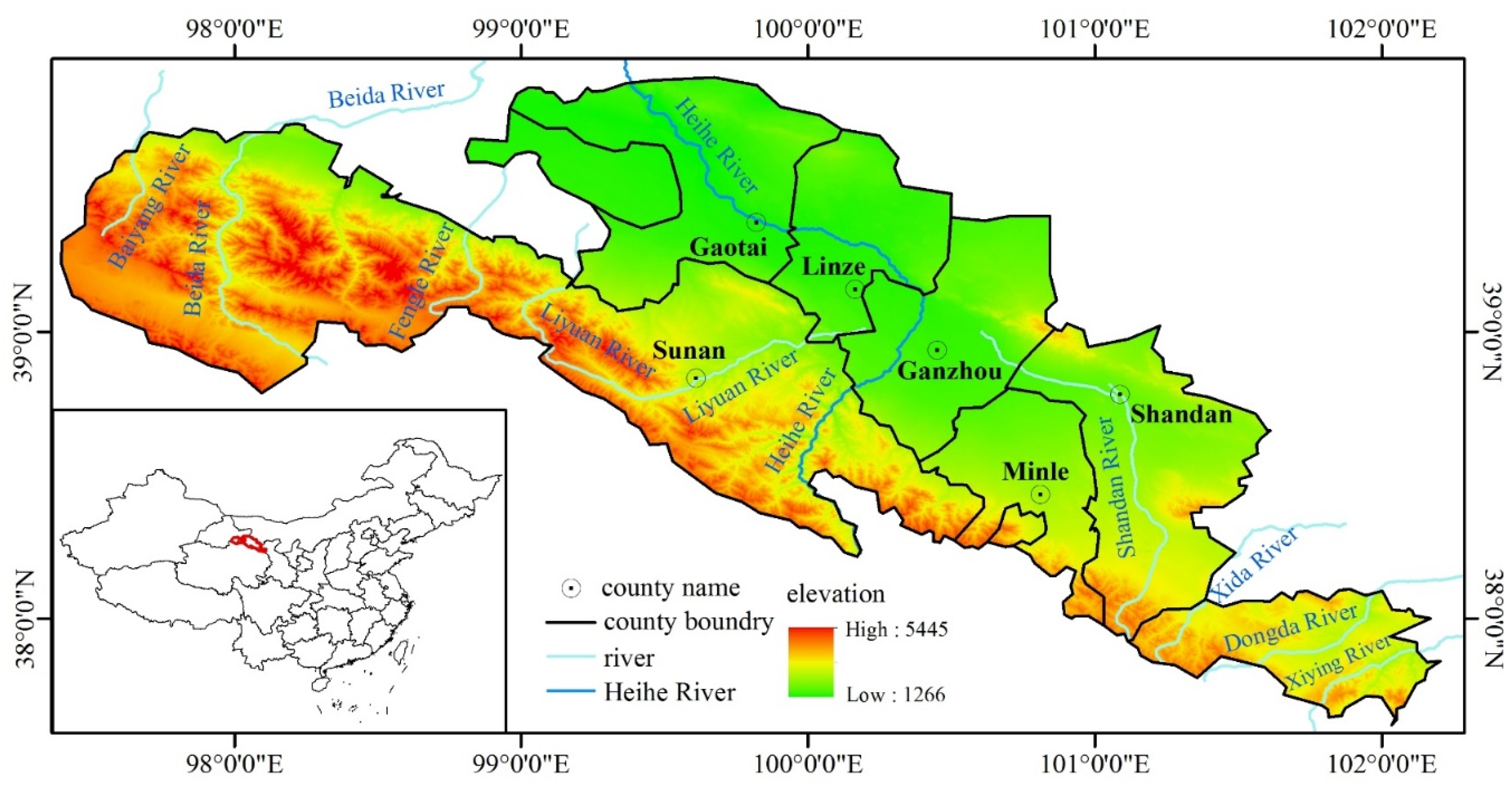

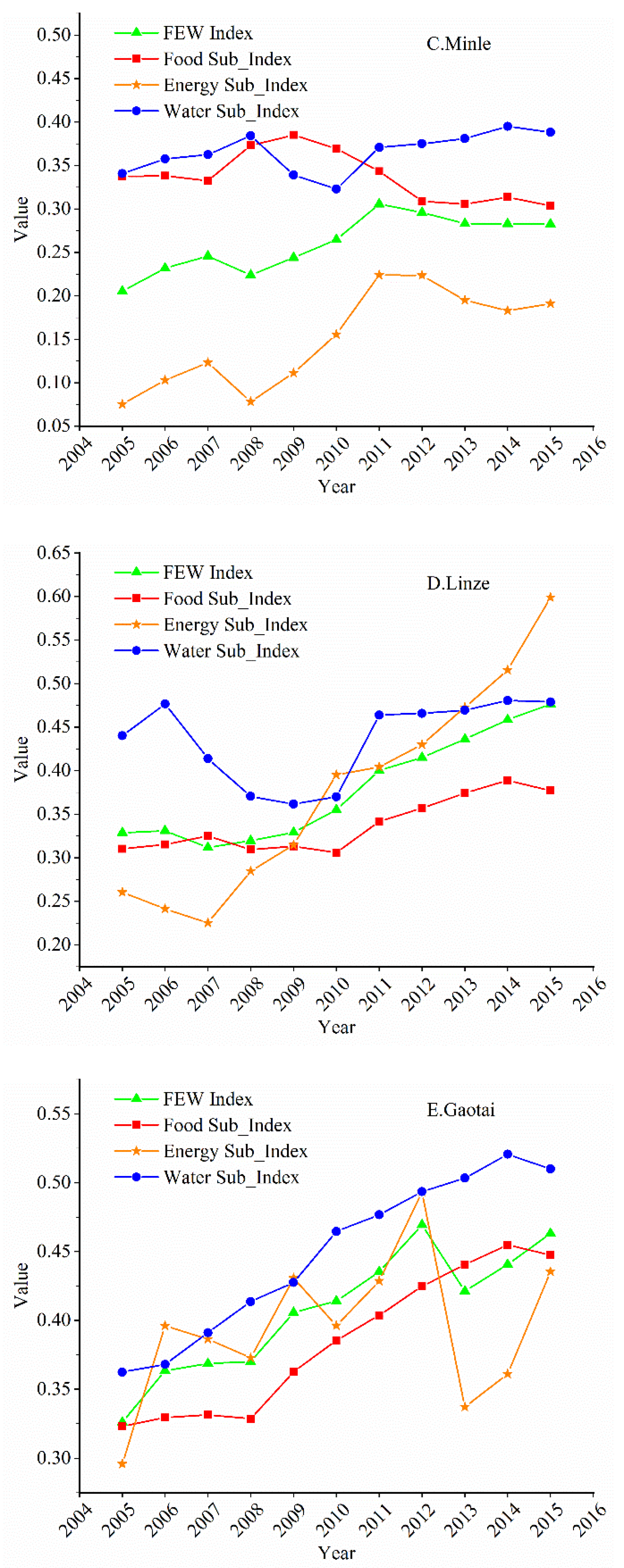


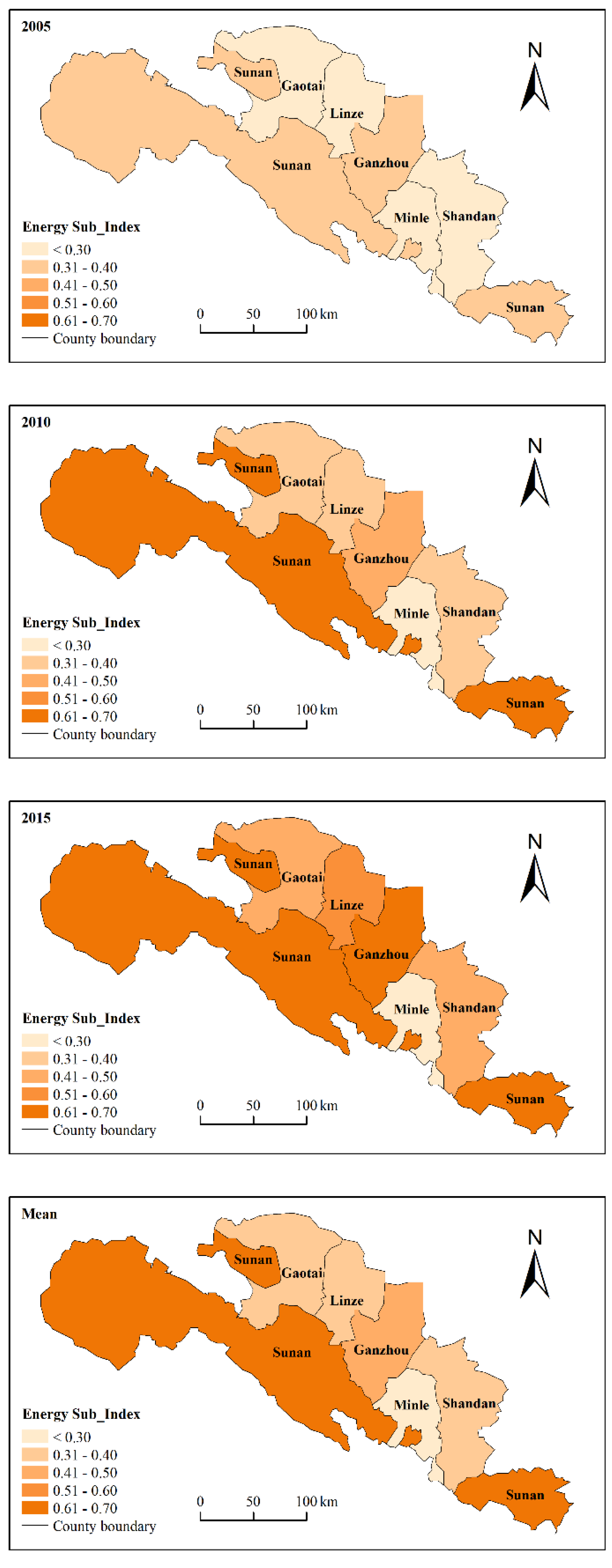
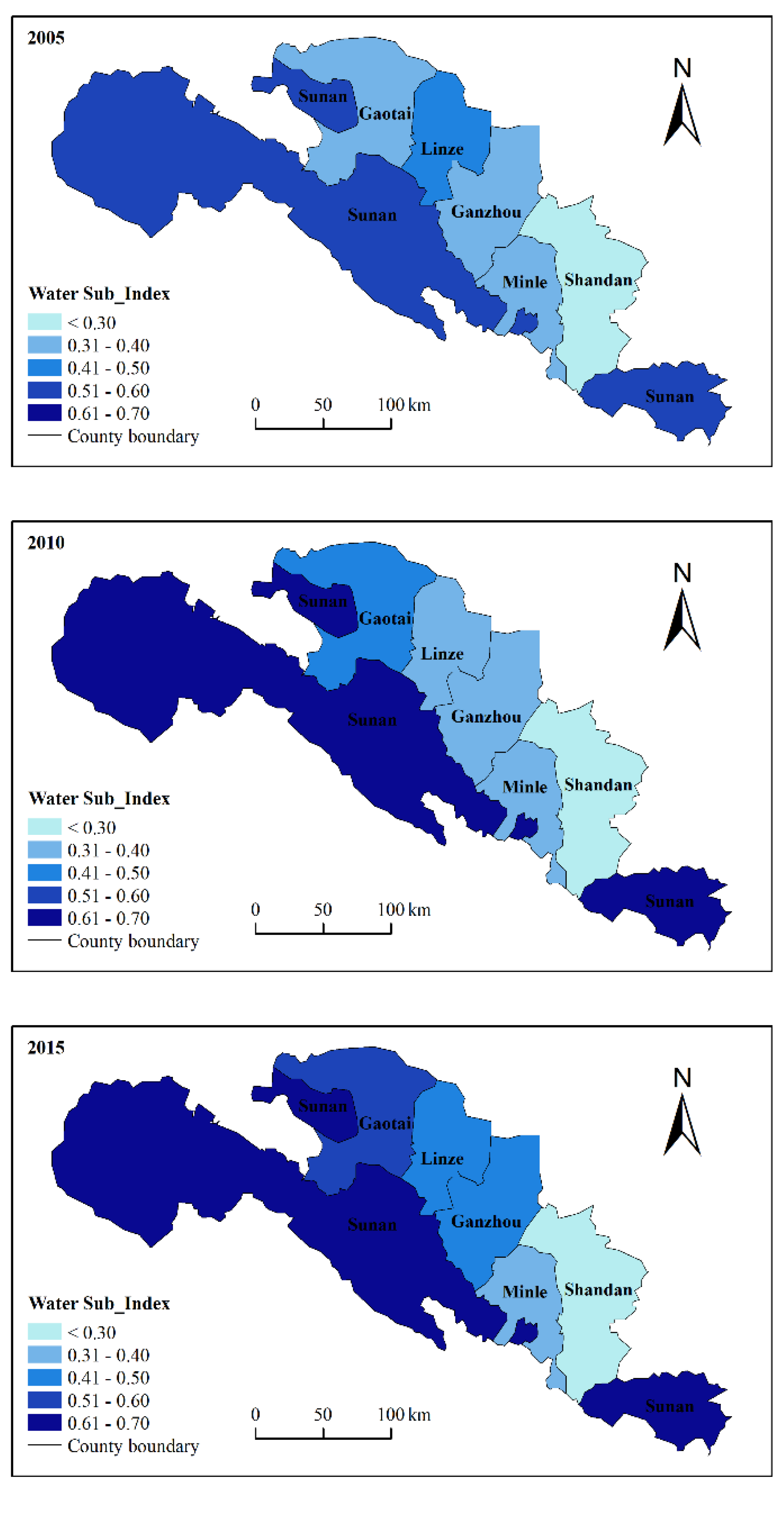
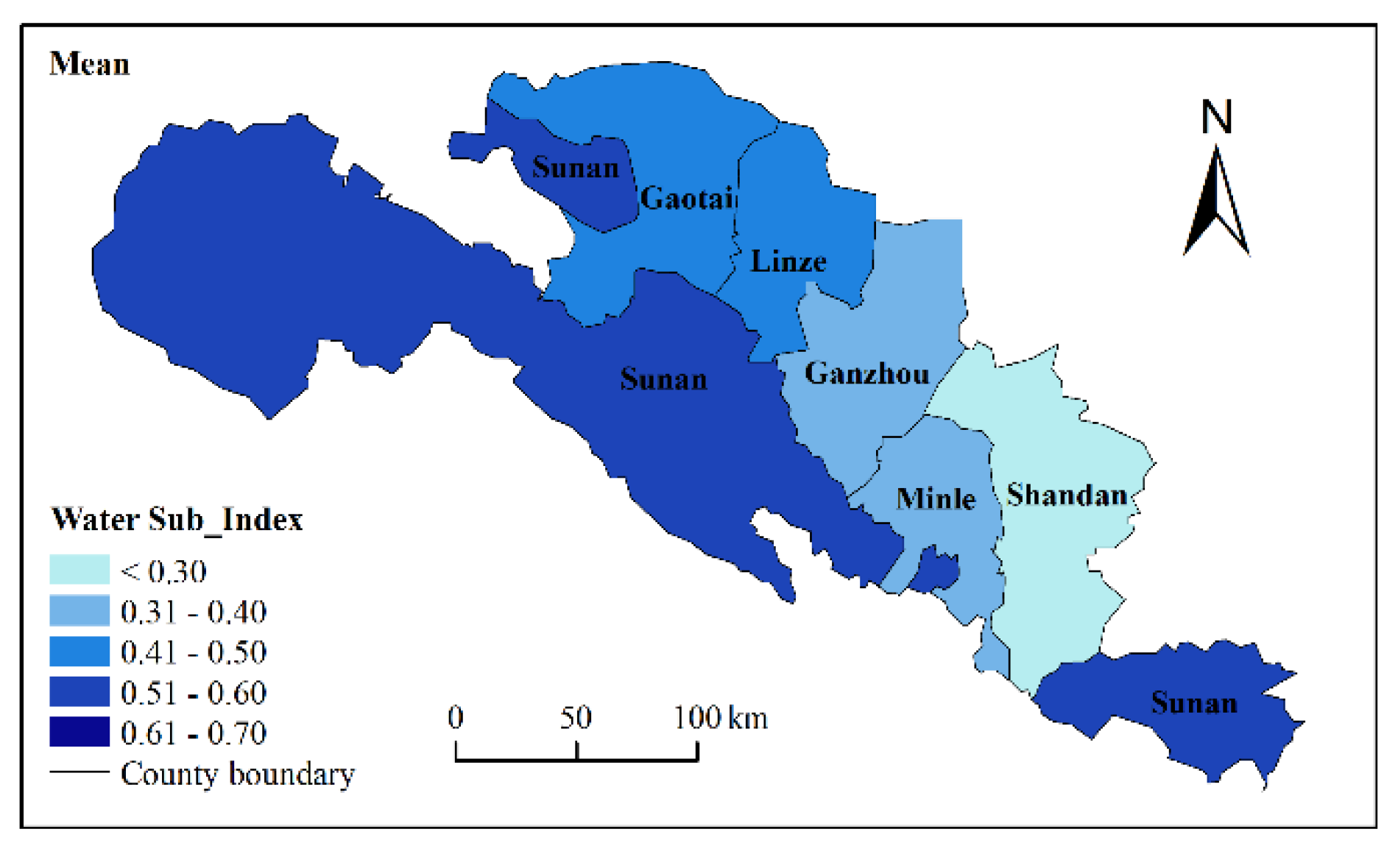


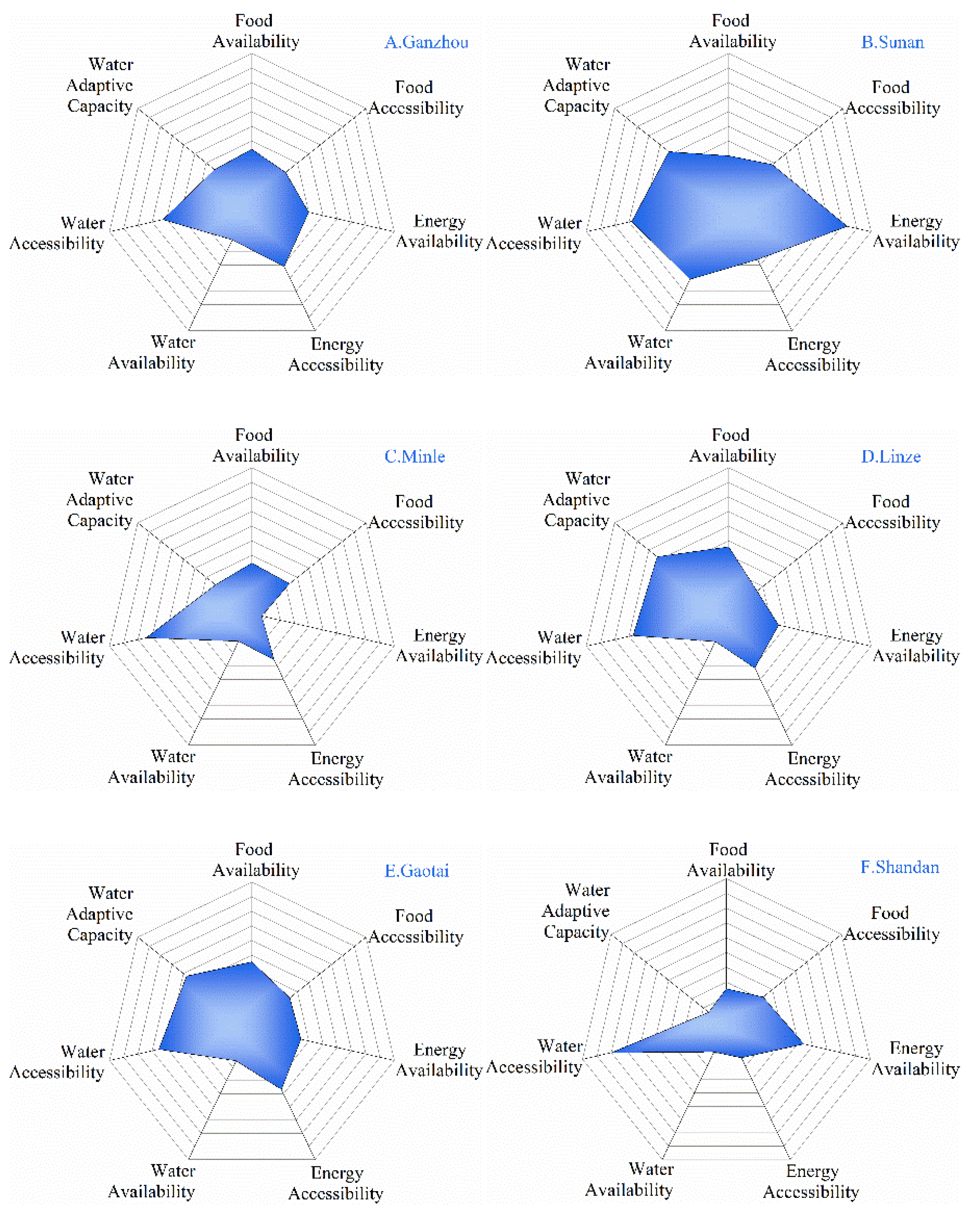
| Indicators | Minimum Value | Maximum Value |
|---|---|---|
| Food Subindex | ||
| Food Availability | ||
| the Ratio of Energy Supply to MDER | 0 | 10 |
| Food Accessibility | ||
| Affordability | 0 | 1 |
| Diversity | 0 | 1 |
| Energy Subindex | ||
| Energy Availability | ||
| Per Capita Electricity Consumption in Rural Areas | 0 | 1000 |
| Energy Accessibility | ||
| Percentage Electrification | 0 | 1 |
| the Average Number of Water Heaters Owned Per 100 Rural Households | 0 | 1 |
| Water Subindex | ||
| Water Availability | ||
| Average Domestic Water Over Population Water Basic Requirement | 0 | 10 |
| Water Accessibility | ||
| Tap Water Usage Rate | 0 | 1 |
| Percentage of People That Have Safe Drinking Water | 0 | 1 |
| Water Adaptive Capacity | ||
| Per Capita Water Resources | 0 | 5000 |
| Categories | Independent Variables | Definition | Unit |
|---|---|---|---|
| socioeconomic | x1 | per capita GDP | Yuan/person |
| x2 | per capita education level | -- | |
| x3 | distance from each county to the city center of Zhangye city | m | |
| x4 | per capita rural labor force | 10000 persons | |
| natural | x5 | average temperature | ℃ |
| x6 | average precipitation | mm | |
| x7 | average evaporation | mm | |
| x8 | average altitude | m | |
| transportation | x9 | distance from each county to the main river | m |
| x10 | distance from each county to the main road | m |
| Model | R | R Square | Adjusted R Square | Std. Error of the Estimate | Sig. |
|---|---|---|---|---|---|
| 1 | 0.887 a | 0.787 | 0.734 | 0.040 | 0.018 |
| 2 | 0.989 b | 0.977 | 0.962 | 0.015 | 0.015 |
| 3 | 0.999 c | 0.997 | 0.993 | 0.006 | 0.062 |
| Model | Sum of Squares | df | Mean Square | F | Sig. | |
|---|---|---|---|---|---|---|
| 1 | Regression | 0.024 | 1 | 0.024 | 14.823 | 0.018 b |
| Residual | 0.006 | 4 | 0.002 | |||
| Total | 0.030 | 5 | ||||
| 2 | Regression | 0.030 | 2 | 0.015 | 64.848 | 0.003 c |
| Residual | 0.001 | 3 | 0.000 | |||
| Total | 0.030 | 5 | ||||
| 3 | Regression | 0.030 | 3 | 0.010 | 245.424 | 0.004 d |
| Residual | 0.000 | 2 | 0.000 | |||
| Total | 0.030 | 5 |
| Model | Unstandardized Coefficients | Standardized Coefficients | t | Sig. | Collinear Statistics | |||
|---|---|---|---|---|---|---|---|---|
| B | Std. Error | Beta | Tolerance | VIF | ||||
| 1 | (constant) | 0.233 | 0.039 | 6.041 | 0.004 | |||
| per capita GDP | 6.416 × 10−6 | 0.000 | 0.887 | 3.850 | 0.018 | 1.000 | 1.000 | |
| 2 | (constant) | 0.317 | 0.022 | 14.319 | 0.001 | |||
| per capita GDP | 8.520 × 10−6 | 0.000 | 1.178 | 11.289 | 0.001 | 0.692 | 1.446 | |
| average altitude | −6.026 × 10−5 | 0.000 | −0.524 | −5.020 | 0.015 | 0.692 | 1.446 | |
| 3 | (constant) | 0.409 | 0.026 | 15.955 | 0.004 | |||
| per capita GDP | 8.633 × 10−6 | 0.000 | 1.194 | 26.867 | 0.001 | 0.686 | 1.458 | |
| average altitude | −6.260 × 10−5 | 0.000 | −0.544 | −12.212 | 0.007 | 0.682 | 1.467 | |
| average evaporation | −5.168 × 10−5 | 0.000 | −0.142 | −3.833 | 0.062 | 0.985 | 1.015 | |
© 2020 by the authors. Licensee MDPI, Basel, Switzerland. This article is an open access article distributed under the terms and conditions of the Creative Commons Attribution (CC BY) license (http://creativecommons.org/licenses/by/4.0/).
Share and Cite
Feng, Y.; Zhong, F.; Huang, C.; Gu, J.; Ge, Y.; Song, X. Spatiotemporal Distribution and the Driving Force of the Food-Energy-Water Nexus Index in Zhangye, Northwest China. Sustainability 2020, 12, 2309. https://doi.org/10.3390/su12062309
Feng Y, Zhong F, Huang C, Gu J, Ge Y, Song X. Spatiotemporal Distribution and the Driving Force of the Food-Energy-Water Nexus Index in Zhangye, Northwest China. Sustainability. 2020; 12(6):2309. https://doi.org/10.3390/su12062309
Chicago/Turabian StyleFeng, Yaya, Fanglei Zhong, Chunlin Huang, Juan Gu, Yingchun Ge, and Xiaoyu Song. 2020. "Spatiotemporal Distribution and the Driving Force of the Food-Energy-Water Nexus Index in Zhangye, Northwest China" Sustainability 12, no. 6: 2309. https://doi.org/10.3390/su12062309
APA StyleFeng, Y., Zhong, F., Huang, C., Gu, J., Ge, Y., & Song, X. (2020). Spatiotemporal Distribution and the Driving Force of the Food-Energy-Water Nexus Index in Zhangye, Northwest China. Sustainability, 12(6), 2309. https://doi.org/10.3390/su12062309








